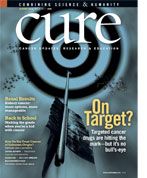Publication
Article
CURE
Web Exclusive: An Infection Out of Nowhere
An infection reminds a breast cancer survivor that implants do not come with a lifetime guarantee.
My cancer journey began spring 1991 with a diagnosis of lobular carcinoma in situ (LCIS), which is not breast cancer but a marker that increases one’s risk for developing invasive breast cancer. For a variety of reasons, I decided to have bilateral prophylactic mastectomy and immediate reconstruction with implants. During surgery, doctors found a stage I ductal carcinoma in the left breast, the same breast as the LCIS. My initial reaction to the news was relief that the decision to have my breasts removed was not totally crazy.
Surgery was the extent of my medical treatment, and I attended a wonderful support group that provided a safe haven for my emotional healing. Over the years, I struggled with the feeling that I wasn’t a “real” cancer survivor. After all, I didn’t have chemo, radiation, or tamoxifen, and I didn’t have to wear prostheses. It wasn’t the full cancer experience. Sort of like I had graduated high school while most of the other cancer survivors I knew had PhDs.
With each year of survivorship, I became more comfortable with my treatment choice. As my “PhD” friends were dealing with premature menopause and other issues, I began to see the upside of no chemo, radiation, etc. My biggest concern was a recurrence, of course, followed by lymphedema.
In distant third was the knowledge that my implants were not, as they say, “life-time devices.” Eventually I figured a doctor would detect a rupture and tell me they needed to be replaced. No drama, just the reality that they had finally worn out.
But more than 16 years after surgery, I developed a staph infection in my right breast. The symptoms came on in a matter of hours. I began feeling feverish and achy then while undressing for bed was shocked to see that my breast was flushed and swollen. It was 9 p.m. and my husband was out of town, so I frantically called my gynecologist. She called in a prescription for antibiotics and told me she would see me first thing in the morning. When I arrived at her office, she took one look at my breast and said, “Holy moly!” Not the thing one expects to hear from your doc. Given my history, she referred me to a breast surgeon. We gave the antibiotics a few days, but it soon became apparent they weren’t getting the job done so it was on to the plastic surgeon.
By the time they rolled me into surgery, I was so ready to get rid of the implant. My breast had almost doubled in size and was as hard as a basketball. The infection had settled in the scar capsule that naturally forms around implants and surgery revealed that my implant had ruptured, but there was no way of knowing when. Though theories were offered, no one knows for sure how I got the infection or whether it was directly related to the rupture.
I spent three days in the hospital on IV antibiotics, peeking under the bandages at my breast, which looked like a collapsed tent. The infectious disease doctor prescribed a wickedly expensive oral antibiotic that came with a long list of foods I should avoid, turned my tongue dark brown, and made most everything taste tinny. I made do with a cheap prosthesis while waiting four months to make sure the infection was gone before proceeding with the next step to rebuild my right breast.
In total, reconstructing the deconstruction took nine months, three more surgeries, surgical drains, expanders, and a matching implant for the left side. I also developed a painful rotator cuff impingement in my left shoulder, which I believe resulted from favoring my right side. That led to 12 weeks of physical therapy.
My new breasts don’t exactly match, but then again, they’ve been through a lot. Just like my breast cancer, the infection seemed to have come out of nowhere with no rhyme or reason—but reminding me once again that this is a journey.
—Diana Rowden is vice president of Health Sciences for Susan G. Komen for the Cure in Dallas.





